Evaluation of the Effects of Forest on Slope Stability and Its Implications for Forest Management: A Case Study of Bailong River Basin, China
Abstract
1. Introduction
2. Materials and Methods
2.1. Vegetation and Site Characteristics
2.2. Field Investigation of Root Systems
2.3. Measurement of Root Tensile Strength
2.4. In Situ Direct Shear Measurements
2.5. Estimation of the Mechanical Stabilization Effect of Robinia Pseudoacacia on Slope Material
2.5.1. Additional Cohesion Effect of Fine Roots
2.5.2. Anchoring Effect of Coarse Roots
2.6. Calculation of Slope Stability
3. Results
3.1. Root Distribution
3.2. Tensile Strength
3.3. The Additional Cohesion and Anchoring Effect of Roots
3.4. Calculation of Slope Stability
4. Discussion
4.1. Characteristics of Root Distributions on the Study Slope
4.2. Tensile Strength of the Roots on the Slope
4.3. Influence of Root Anchorage on Slope Stability
4.4. Effect of Planting Location on Slope Stability
5. Conclusions
Author Contributions
Funding
Acknowledgments
Conflicts of Interest
References
- Cohen, D.; Lehmann, P.; Or, D. Fiber bundle model for multiscale modeling of hydromechanical triggering of shallow landslides. Water Resour. Res. 2009, 45, 1–20. [Google Scholar] [CrossRef]
- Schmidt, K.; Roering, J.; Stock, J.; Dietrich, W.; Montgomery, D.; Schaub, T. The variability of root cohesion as an influence on shallow landslide susceptibility in the Oregon Coast Range. Can. Geotech. J. 2001, 38, 995–1024. [Google Scholar] [CrossRef]
- Li, Y.; Wang, Y.; Ma, C.; Zhang, H.; Wang, Y.; Song, S.; Zhu, J. Influence of the spatial layout of plant roots on slope stability. Ecol. Eng. 2016, 91, 477–486. [Google Scholar] [CrossRef]
- Temgoua, A.G.T.; Kokutse, N.K.; Kavazović, Z. Influence of forest stands and root morphologies on hillslope stability. Ecol. Eng. 2016, 95, 622–634. [Google Scholar] [CrossRef]
- Kim, J.H.; Fourcaud, T.; Jourdan, C.; Maeght, J.L.; Mao, Z.; Metayer, J.; Meylan, L.; Pierret, A.; Rapidel, B.; Roupsard, O. Vegetation as a driver of temporal variations in slope stability: The impact of hydrological processes. Geophys. Res. Lett. 2017, 44, 4897–4907. [Google Scholar] [CrossRef]
- Shen, P.; Zhang, L.M.; Chen, H.X.; Gao, L. Role of vegetation restoration in mitigating hillslope erosion and debris flows. Eng. Geol. 2017, 216, 122–133. [Google Scholar] [CrossRef]
- Coppin, N.; Richards, I.G. Use of Vegetation in Civil Engineering; Butterworth-Heinemann: Oxford, UK, 1990. [Google Scholar]
- Ni, J.J.; Leung, A.K.; Ng, C.W.W.; Shao, W. Modelling hydro-mechanical reinforcements of plants to slope stability. Comput. Geotech. 2018, 95, 99–109. [Google Scholar] [CrossRef]
- Das, G.K.; Hazra, B.; Garg, A.; Ng, C.W.W. Stochastic hydro-mechanical stability of vegetated slopes: An integrated copula based framework. CATENA 2018, 160, 124–133. [Google Scholar] [CrossRef]
- Zhu, H.; Zhang, L.M.; Xiao, T.; Li, X.Y. Enhancement of slope stability by vegetation considering uncertainties in root distribution. Comput. Geotech. 2017, 85, 84–89. [Google Scholar] [CrossRef]
- Li, K.; Zhang, G. Soil and Water Conservation Forest; China Science Publishing: Beijing, China, 2012. [Google Scholar]
- Xu, M.; Gao, D.; Fu, S.; Lu, X.; Wu, S.; Han, X.; Yang, G.; Feng, Y. Long-term effects of vegetation and soil on the microbial communities following afforestation of farmland with Robinia pseudoacacia plantations. Geoderma 2020, 367, 114263. [Google Scholar] [CrossRef]
- Xu, Y.; Wang, T.; Li, H.; Ren, C.; Chen, J.; Yang, G.; Han, X.; Feng, Y.; Ren, G.; Wang, X. Variations of soil nitrogen-fixing microorganism communities and nitrogen fractions in a Robinia pseudoacacia chronosequence on the Loess Plateau of China. CATENA 2019, 174, 316–323. [Google Scholar] [CrossRef]
- Wang, S.; Meng, X.; Chen, G.; Guo, P.; Xiong, M.; Zeng, R. Effects of vegetation on debris flow mitigation: A case study from Gansu province, China. Geomorphology 2017, 282, 64–73. [Google Scholar] [CrossRef]
- Gray, D.H.; Sotir, R.B. Biotechnical and Soil Bioengineering Slope Stabilization: A Practical Guide for Erosion Control; Wiley-Interscience: Hoboken, NJ, USA, 1996. [Google Scholar]
- Zhang, C.-B.; Chen, L.-H.; Liu, Y.-P.; Ji, X.-D.; Liu, X.-P. Triaxial compression test of soil–root composites to evaluate influence of roots on soil shear strength. Ecol. Eng. 2010, 36, 19–26. [Google Scholar] [CrossRef]
- Wu, T.H.; McKinnell Iii, W.P.; Swanston, D.N. Strength of tree roots and landslides on Prince of Wales Island, Alaska. Can. Geotech. J. 1979, 16, 19–33. [Google Scholar] [CrossRef]
- Wu, T.H. Root reinforcement of soil: Review of analytical models, test results, and applications to design. Can. Geotech. J. 2013, 50, 259–274. [Google Scholar] [CrossRef]
- Preti, F.; Schwarz, M. On root reinforcement modelling. In Geophysical Research Abstrsacts; European Geosciences Union: Munich, Germany, 2006; pp. 2–7. [Google Scholar]
- Hubble, T.C.T.; Airey, D.W.; Sealey, H.K.; De Carli, E.V.; Clarke, S.L. A little cohesion goes a long way: Estimating appropriate values of additional root cohesion for evaluating slope stability in the Eastern Australian highlands. Ecol. Eng. 2013, 61, 621–632. [Google Scholar] [CrossRef]
- Schutten, J.; Dainty, J.; Davy, A.J. Root Anchorage and Its Significance for Submerged Plants in Shallow Lakes. J. Ecol. 2010, 93, 556–571. [Google Scholar] [CrossRef]
- Dupuy, L.; Fourcaud, T.; Stokes, A. A numerical investigation into the influence of soil type and root architecture on tree anchorage. Plant Soil 2005, 278, 119–134. [Google Scholar] [CrossRef]
- Fourcaud, T.; Ji, J.N.; Zhang, Z.Q.; Stokes, A. Understanding the Impact of Root Morphology on Overturning Mechanisms: A Modelling Approach. Ann. Bot. 2008, 101, 1267–1280. [Google Scholar] [CrossRef]
- Kamimura, K.; Kitagawa, K.; Saito, S.; Mizunaga, H. Root anchorage of hinoki (Chamaecyparis obtuse (Sieb. Et Zucc.) Endl.) under the combined loading of wind and rapidly supplied water on soil: Analyses based on tree-pulling experiments. Eur. J. For. Res. 2012, 131, 219–227. [Google Scholar] [CrossRef]
- Sun, H.-L.; Li, S.-C.; Xiong, W.-L.; Yang, Z.-R.; Cui, B.-S.; Tao, Y. Influence of slope on root system anchorage of Pinus yunnanensis. Ecol. Eng. 2008, 32, 60–67. [Google Scholar] [CrossRef]
- Li, S.-C.; Sun, H.-L.; Yang, Z.-R.; Xiong, W.-L.; Cui, B.-S. Root anchorage of Vitex negundo L. on rocky slopes under different weathering degrees. Ecol. Eng. 2007, 30, 27–33. [Google Scholar] [CrossRef]
- Ji, J.; Kokutse, N.; Genet, M.; Fourcaud, T.; Zhang, Z. Effect of spatial variation of tree root characteristics on slope stability. A case study on Black Locust (Robinia pseudoacacia) and Arborvitae (Platycladus orientalis) stands on the Loess Plateau, China. CATENA 2012, 92, 139–154. [Google Scholar] [CrossRef]
- Stokes, A.; Norris, J.E.; Greenwood, J.R. Introduction to Ecotechnological Solutions; Springer: Dordrecht, The Netherlands, 2008; pp. 1–8. [Google Scholar]
- Hales, T.C.; Ford, C.R.; Hwang, T.; Vose, J.M.; Band, L.E. Topographic and ecologic controls on root reinforcement. J. Geophys. Res. Earth Surf. 2009, 114. [Google Scholar] [CrossRef]
- Schwarz, M.; Lehmann, P.; Or, D. Quantifying lateral root reinforcement in steep slopes—from a bundle of roots to tree stands. Earth Surf. Process. Landf. 2010, 35, 354–367. [Google Scholar] [CrossRef]
- Mao, Z.; Saint-André, L.; Genet, M.; Mine, F.-X.; Jourdan, C.; Rey, H.; Courbaud, B.; Stokes, A. Engineering ecological protection against landslides in diverse mountain forests: Choosing cohesion models. Ecol. Eng. 2012, 45, 55–69. [Google Scholar] [CrossRef]
- Bhom, W. Methods of Studying Root Systems; Springer: Berlin, Germany, 1979. [Google Scholar]
- Wang, S.; Zeng, R.; Qiao, L.; Meng, X.; Wangle, X.; Cui, Z. Root distribution and tensile strength of Robinia pseudoacacia Linn. on debris slopes. J. Lanzhou Univ. (Nat. Sci.) 2014, 50, 18. (In Chinese) [Google Scholar]
- Schwarz, M.; Giadrossich, F.; Cohen, D. Modeling root reinforcement using root-failure Weibull survival function. Hydrol. Earth Syst. Sci. Discuss. 2013, 10, 3843–3868. [Google Scholar] [CrossRef]
- Nguyen, T.S.; Likitlersuang, S.; Jotisankasa, A. Influence of the spatial variability of the root cohesion on a slope-scale stability model: A case study of residual soil slope in Thailand. Bull. Eng Geol Environ. 2019, 78, 3337–3351. [Google Scholar] [CrossRef]
- Genet, M.; Kokutse, N.; Stokes, A.; Fourcaud, T.; Cai, X.; Ji, J.; Mickovski, S. Root reinforcement in plantations of Cryptomeria japonica D. Don: Effect of tree age and stand structure on slope stability. For. Ecol. Manag. 2008, 256, 1517–1526. [Google Scholar] [CrossRef]
- Bischetti, G.B.; Chiaradia, E.A.; Simonato, T.; Speziali, B.; Vitali, B.; Vullo, P.; Zocco, A. Root strength and root area ratio of forest species in Lombardy (Northern Italy). Plant Soil 2005, 278, 11–22. [Google Scholar] [CrossRef]
- Nilaweera, N.S.; Nutalaya, P. Role of tree roots in slope stabilisation. Bull. Eng Geol Environ. 1999, 57, 337–342. [Google Scholar] [CrossRef]
- Lin, Z. Geotechnical Engineering Test Manual; China Architecture & Building Press: Beijing, China, 2005. [Google Scholar]
- Schwarz, M.; Preti, F.; Giadrossich, F.; Lehmann, P.; Or, D. Quantifying the role of vegetation in slope stability: A case study in Tuscany (Italy). Ecol. Eng. 2010, 36, 285–291. [Google Scholar] [CrossRef]
- Chirico, G.B.; Borga, M.; Tarolli, P.; Rigon, R.; Preti, F. Role of Vegetation on Slope Stability under Transient Unsaturated Conditions. Procedia Environ. Sci. 2013, 19, 932–941. [Google Scholar] [CrossRef]
- Greenwood, J.R.; Norris, J.; Wint, J. Assessing the contribution of vegetation to slope stability. Proc. Inst. Civ. Eng. Geotech. Eng. 2004, 157, 199–207. [Google Scholar] [CrossRef]
- Ennos, A. The mechanics of root anchorage. Adv. Bot. Res. 2000, 33, 133–157. [Google Scholar]
- Carson, M.A.; Kirkby, M.J. Hillslope Form and Process; Cambridge University Press: Cambridge, UK, 1972. [Google Scholar]
- Fellenius, W. Erdstatishe Berechmungen Mit Reibungund Cohesion; Ernest Verlag: Berlim, Germany, 1927. [Google Scholar]
- Bishop, A.W. The use of the slip circle in the stability analysis of slopes. In The Essence of Geotechnical Engineering: 60 Years of Géotechnique; Thomas Telford Publishing: London, UK, 2008; pp. 223–233. [Google Scholar]
- Janbu, N.; Bjerrum, L.; Kjaernsli, B. Soil Mechanics Applied to Some Engineering Problems; Norwegian Geotechnical Institute: Olso, Norway, 1956. [Google Scholar]
- Morgenstern, N.; Price, V. A numerical method for solving the equations of stability of general slip surfaces. Comput. J. 1967, 9, 388–393. [Google Scholar] [CrossRef]
- Konôpka, B.; Noguchi, K.; Sakata, T.; Takahashi, M.; Konôpková, Z. Fine root dynamics in a Japanese cedar (Cryptomeria japonica) plantation throughout the growing season. For. Ecol. Manag. 2006, 225, 278–286. [Google Scholar] [CrossRef]
- Danjon, F.; Khuder, H.; Stokes, A. Deep Phenotyping of Coarse Root Architecture in R. pseudoacacia Reveals That Tree Root System Plasticity Is Confined within Its Architectural Model. PLoS ONE 2013, 8, e83548. [Google Scholar] [CrossRef]
- Genet, M.; Stokes, A.; Salin, F.; Mickovski, S.B.; Fourcaud, T.; Dumail, J.-F.; Van Beek, R. The Influence of Cellulose Content on Tensile Strength in Tree Roots. Plant Soil 2005, 278, 1–9. [Google Scholar] [CrossRef]
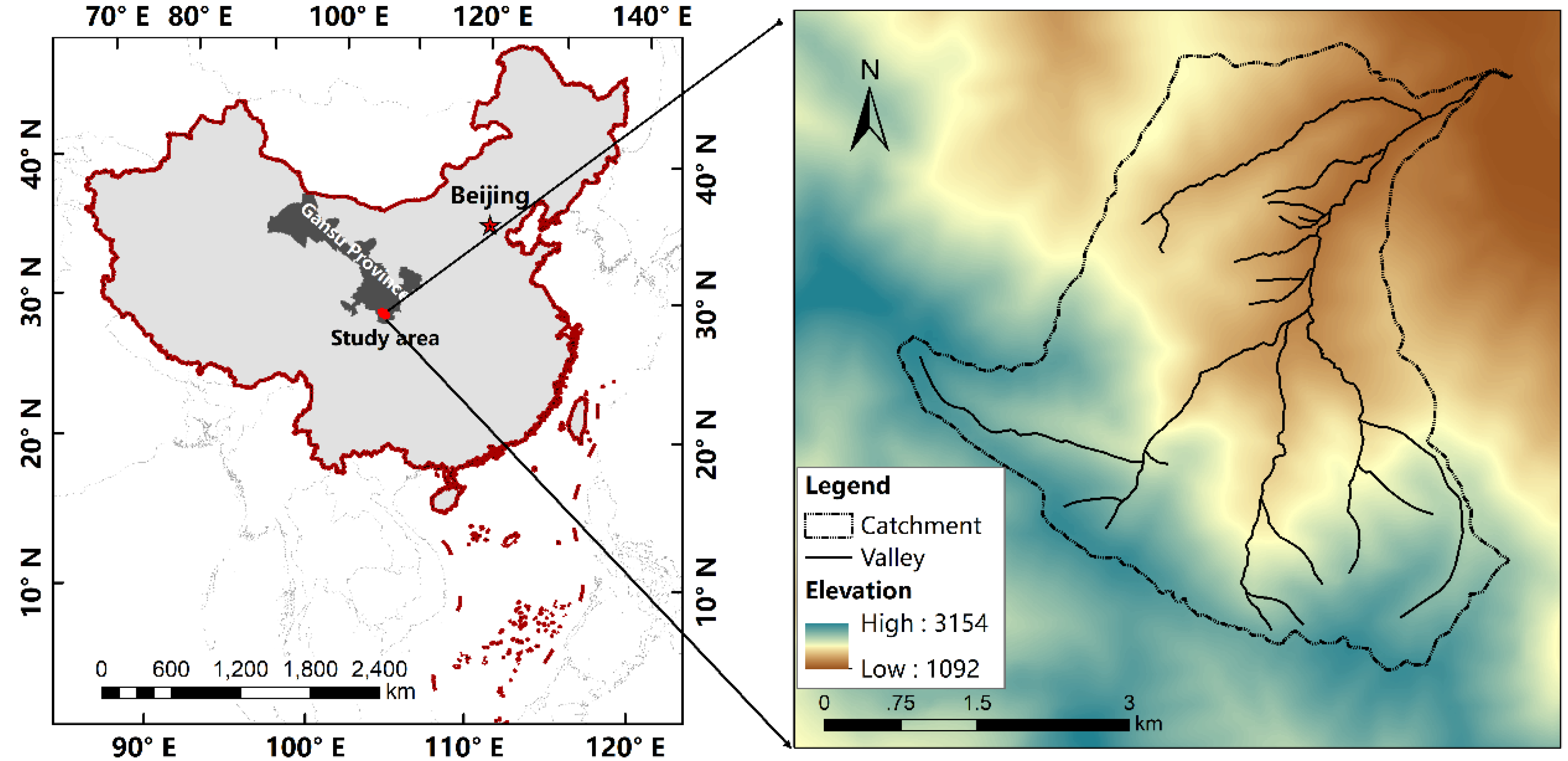
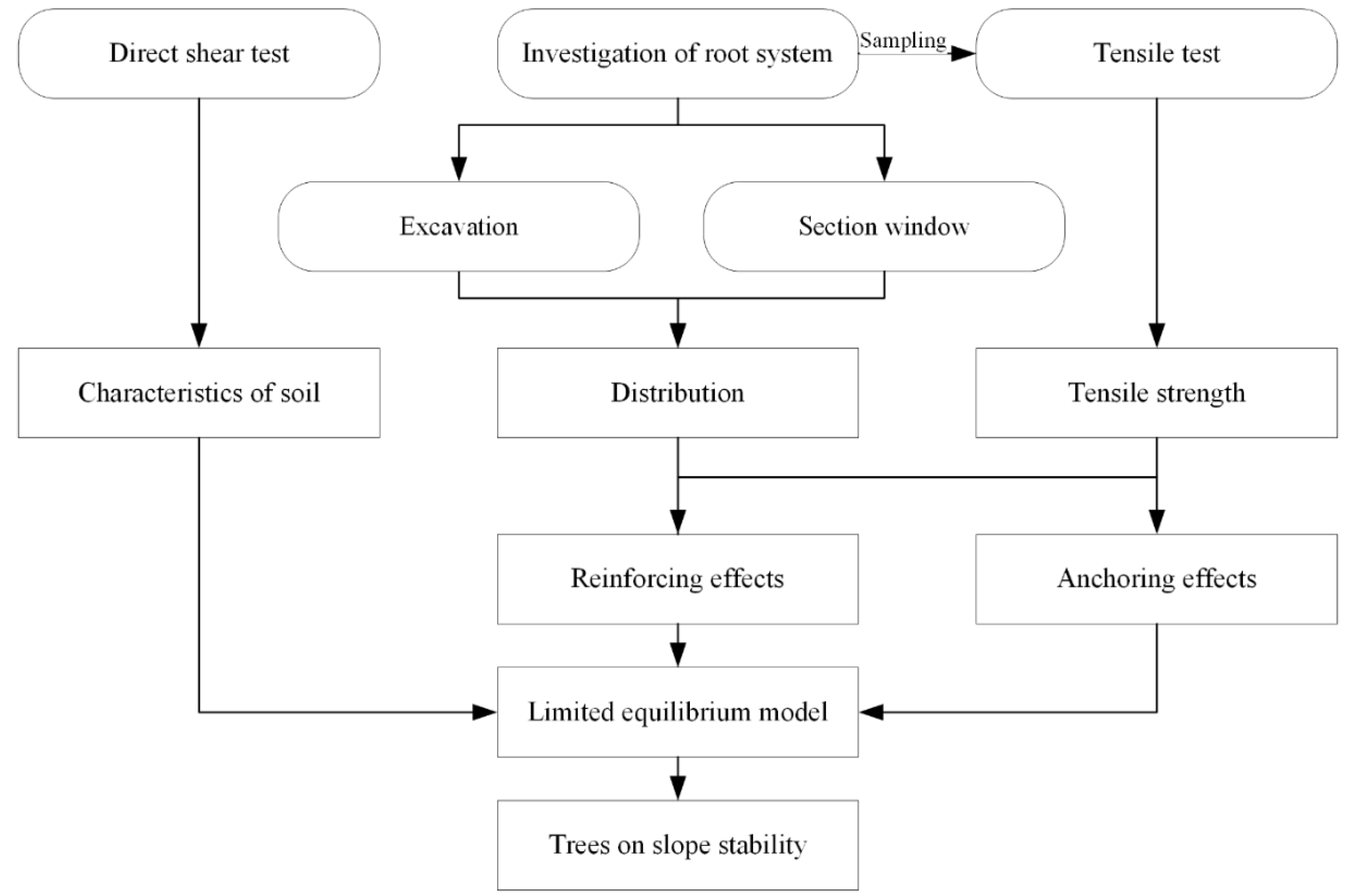
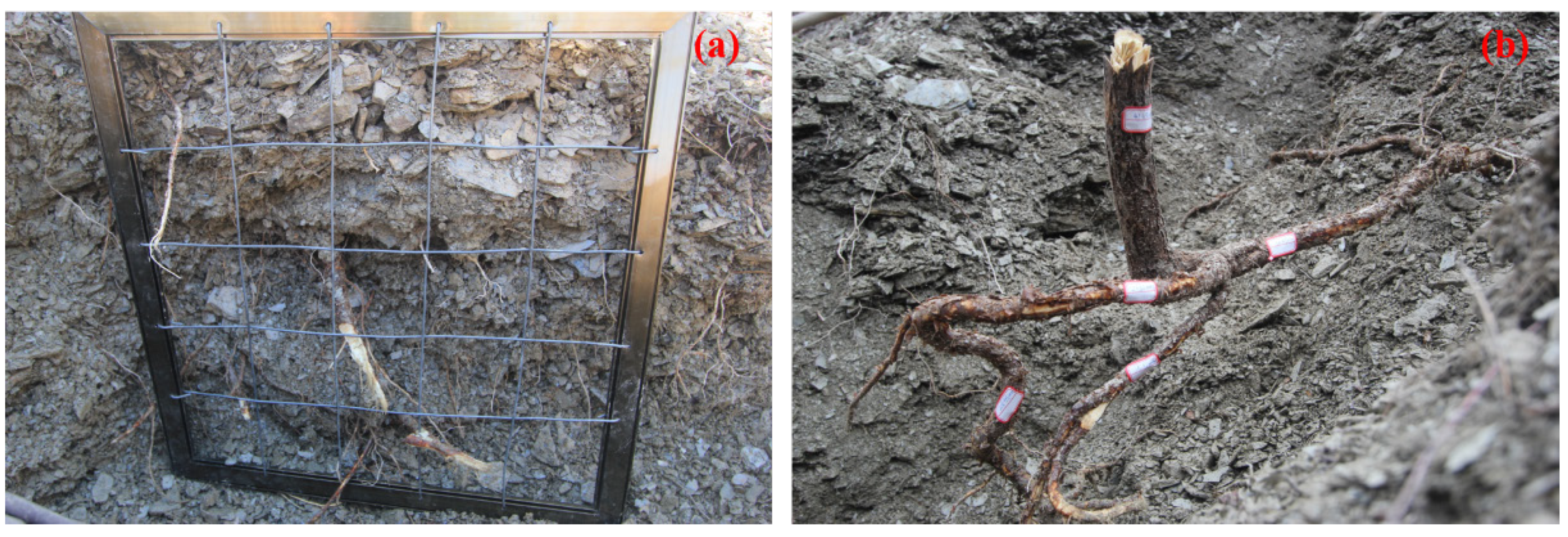
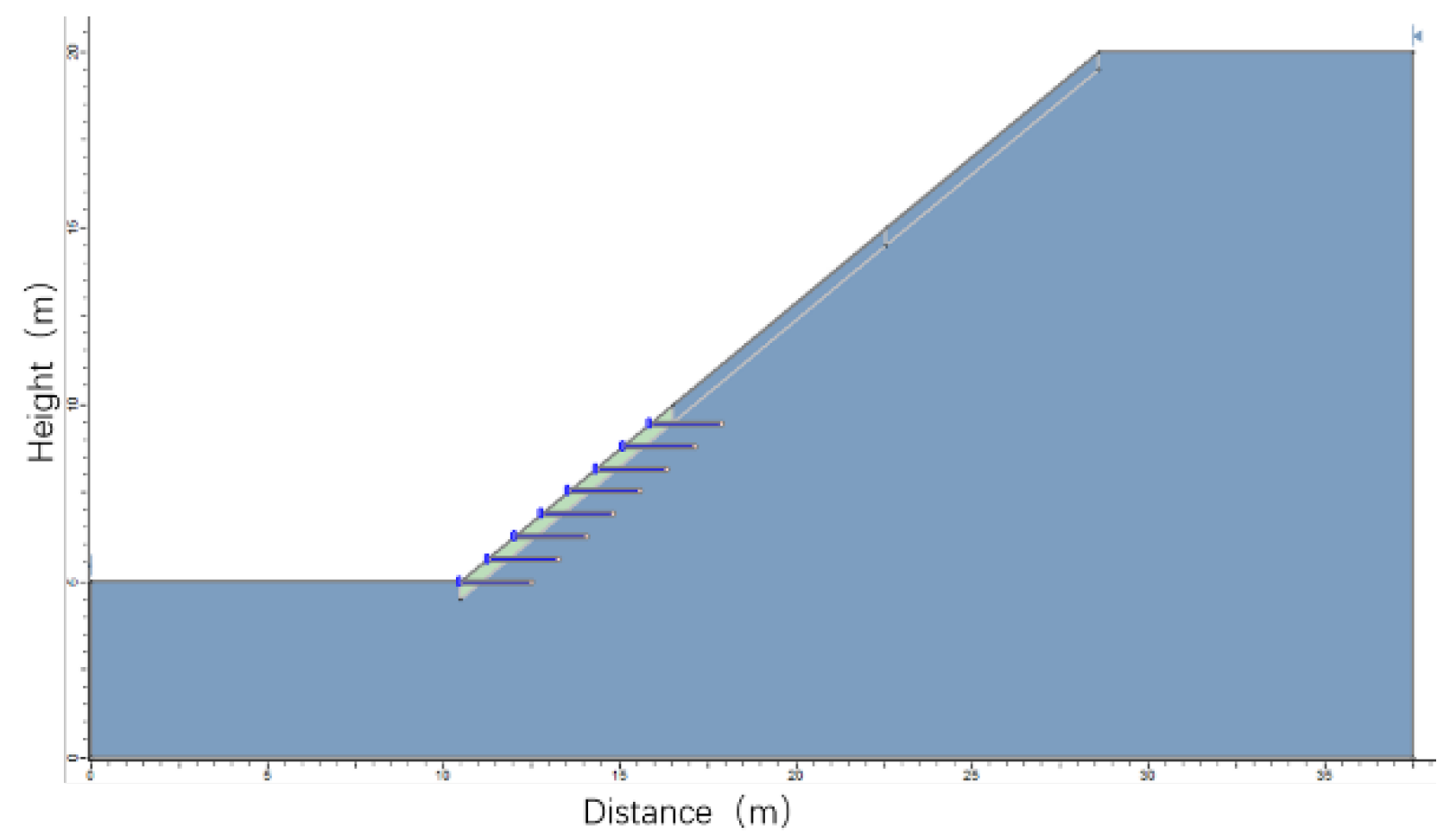
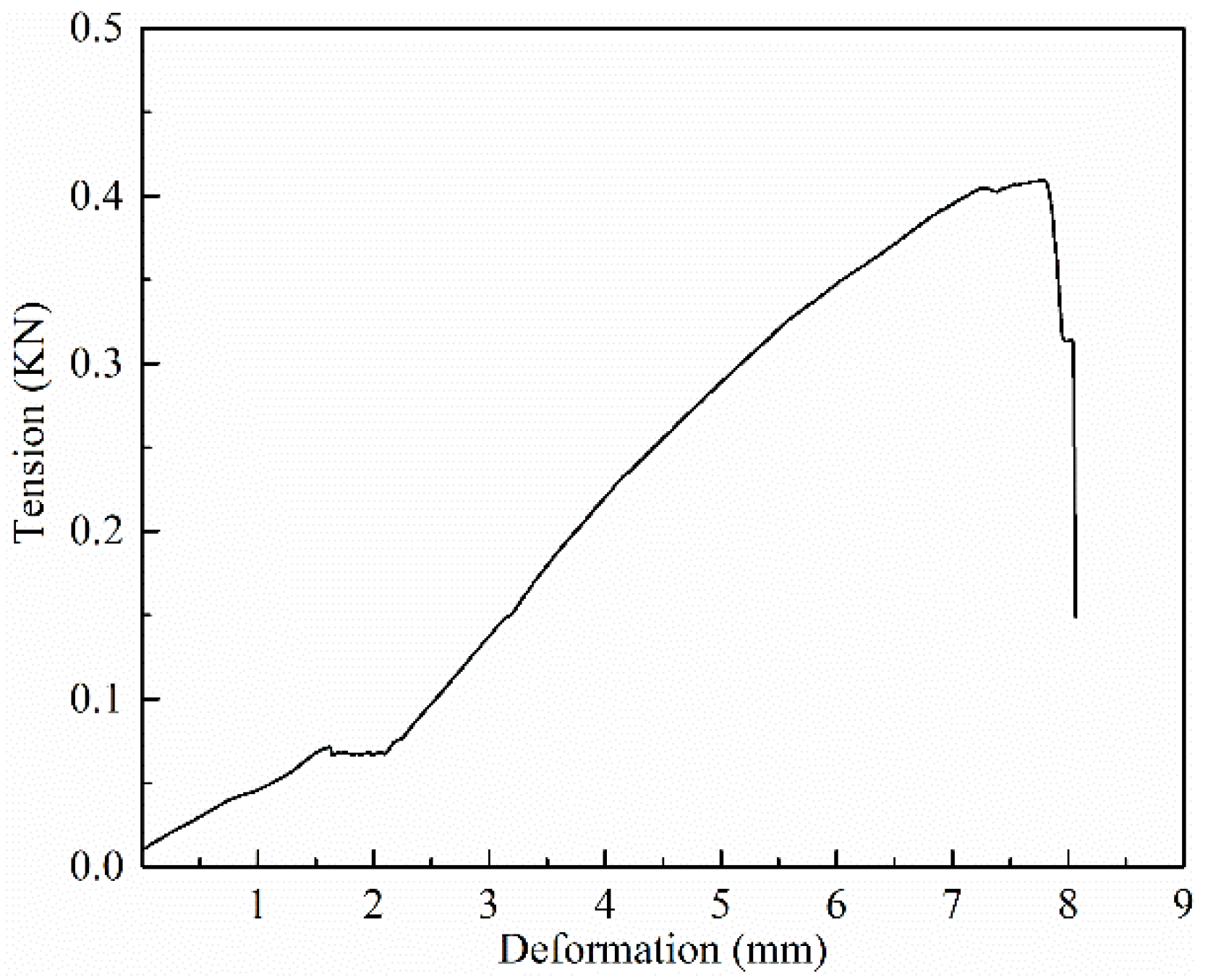
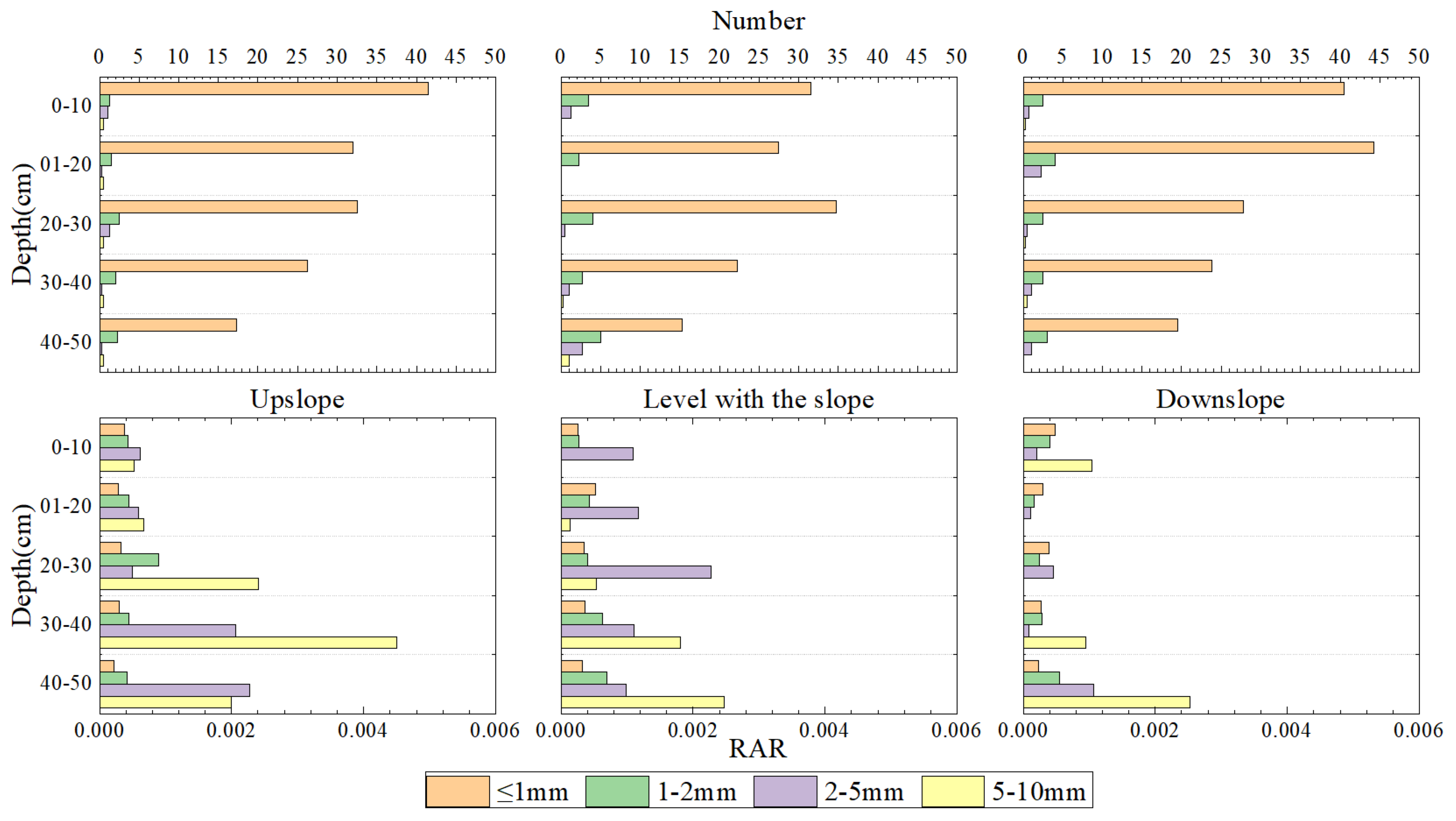
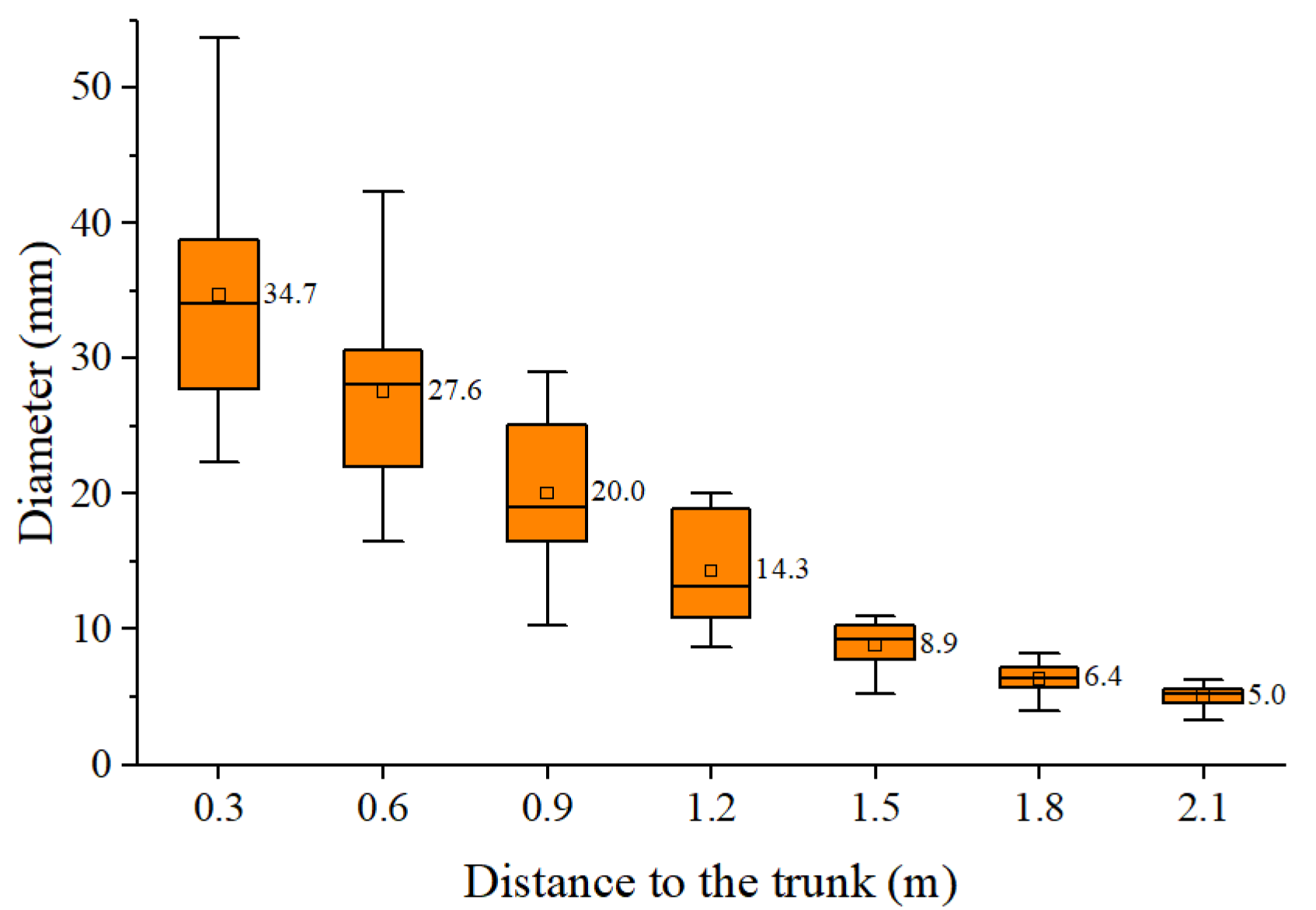
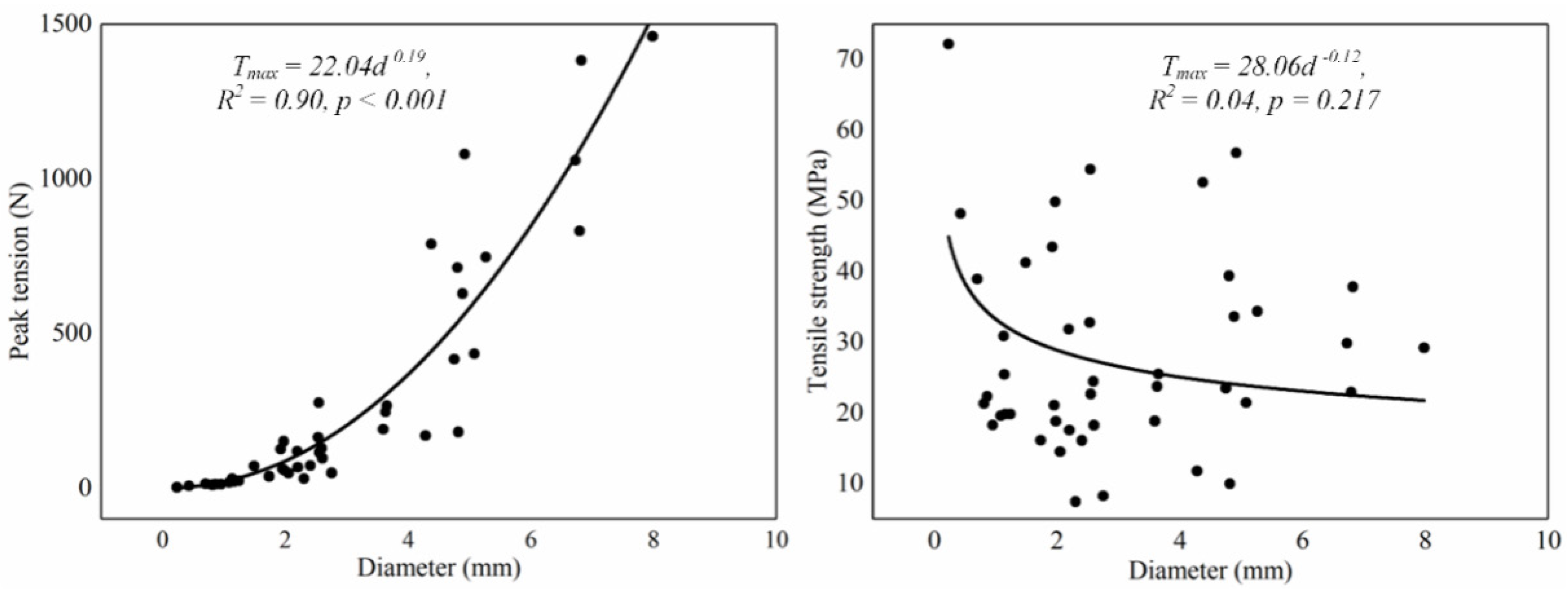
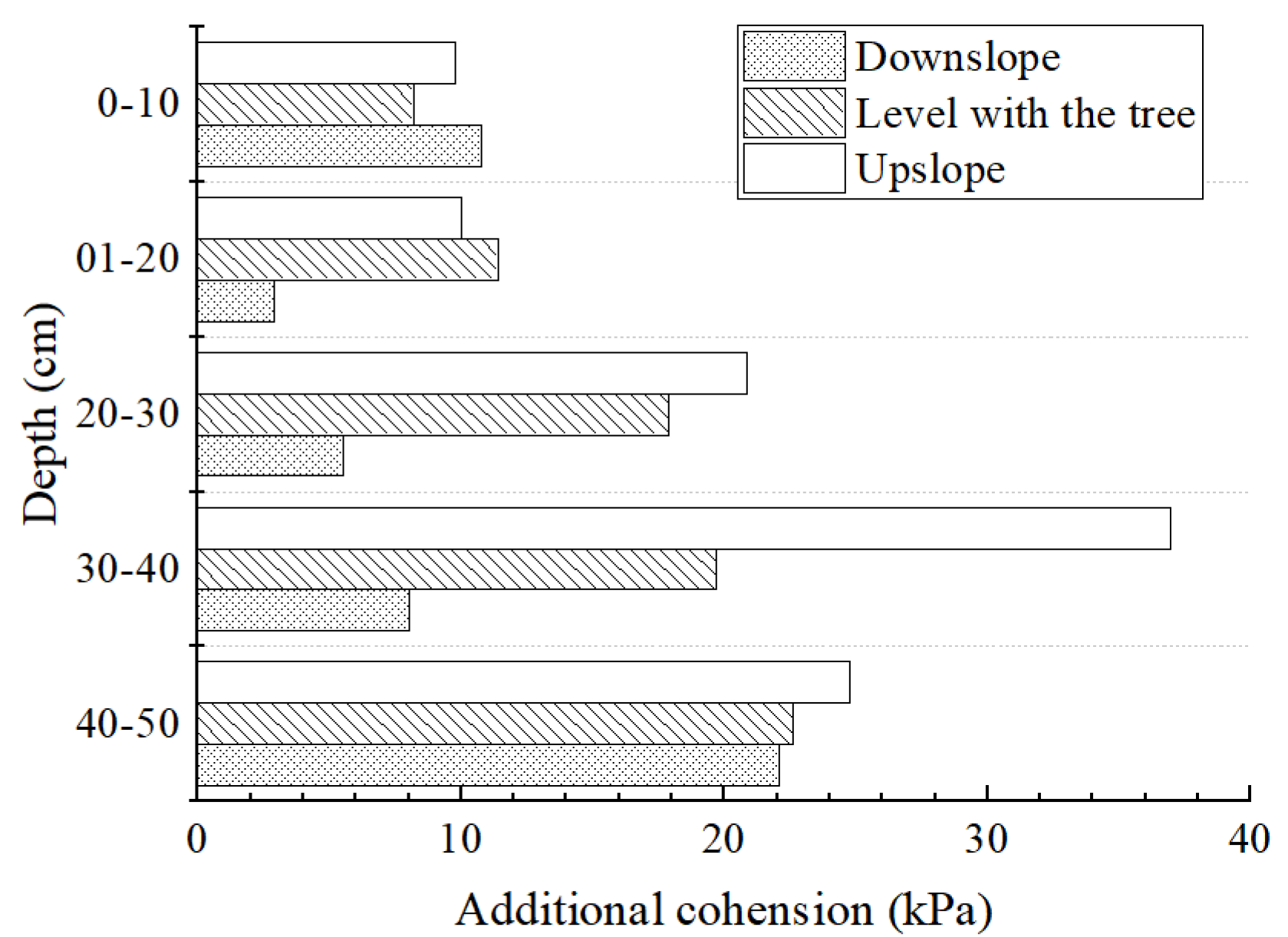
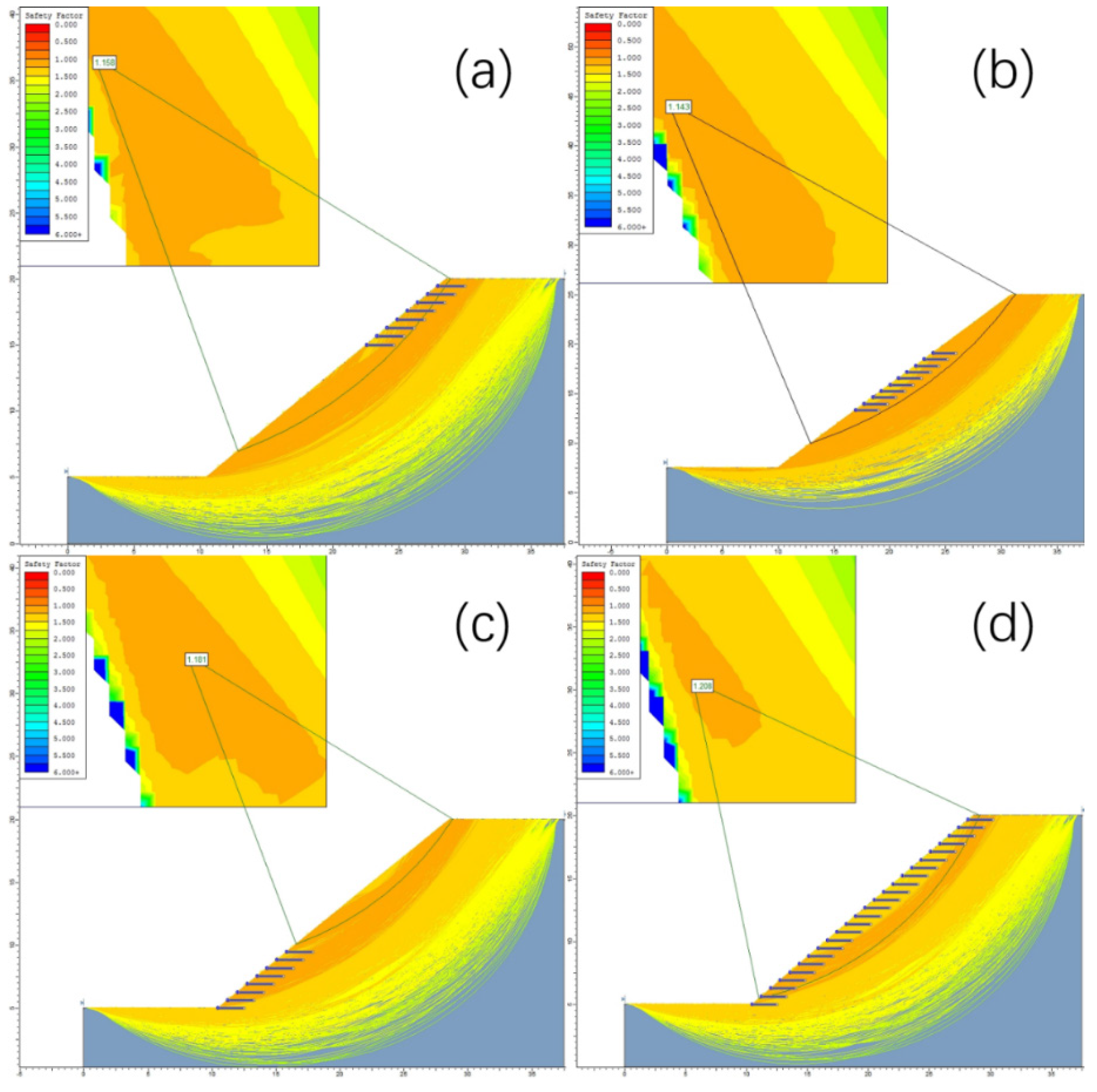

| Item | Value |
|---|---|
| Slope (°) | 39 |
| Bulk density (N/cm3) | 17.3 |
| Cohesion (kPa) | 1.05 |
| Friction angle (°) | 44.7 |
| Additional cohesion by roots (kPa) | 15 |
| Root Diameter Classes | Fitting Function | Correlation Coefficient |
|---|---|---|
| d ≤ 1.0 mm | Rd1 = 149.71e−0.192d | R2 = 0.9175 |
| 1.0 mm ≤ d ≤ 2.0 mm | Rd2 = 6.8147e0.0626d | R2 = 0.4261 |
| 2.0 mm ≤ d ≤ 5.0 mm | Rd3 = 0.34d2 − 1.86d + 4.65 | R2 = 0.8818 |
| 5.0 mm ≤ d ≤ 10.0 mm | Rd4 = 0.09z2 − 0.31z + 0.9 | R2 = 0.9153 |
| Diameter Classes | F Value | p |
|---|---|---|
| d ≤ 1.0 mm | 1.567 | 0.248 |
| 1.0 mm ≤ d ≤ 2.0 mm | 2.567 | 0.118 |
| 2.0 mm ≤ d ≤ 5.0 mm | 6.20 | 0.014 a |
| 5.0 mm ≤ d ≤ 10.0 mm | 6.50 | 0.028 a |
| Planted Location | With/Without Anchorage | Stability Factor | ||
|---|---|---|---|---|
| OF | BS | MP | ||
| Without vegetation | - | 1.157 | 1.149 | 1.192 |
| Upslope | Without | 1.149 | 1.186 | 1.182 |
| Middle slope | Without | 1.159 | 1.197 | 1.176 |
| Lower slope | Without | 1.163 | 1.192 | 1.197 |
| All | Without | 1.202 | 1.27 | 1.266 |
| Upslope | With | 1.158 | 1.196 | 1.195 |
| Middle slope | With | 1.159 | 1.199 | 1.189 |
| Lower slope | With | 1.181 | 1.216 | 1.211 |
| All | With | 1.208 | 1.277 | 1.275 |
© 2020 by the authors. Licensee MDPI, Basel, Switzerland. This article is an open access article distributed under the terms and conditions of the Creative Commons Attribution (CC BY) license (http://creativecommons.org/licenses/by/4.0/).
Share and Cite
Wang, S.; Zhao, M.; Meng, X.; Chen, G.; Zeng, R.; Yang, Q.; Liu, Y.; Wang, B. Evaluation of the Effects of Forest on Slope Stability and Its Implications for Forest Management: A Case Study of Bailong River Basin, China. Sustainability 2020, 12, 6655. https://doi.org/10.3390/su12166655
Wang S, Zhao M, Meng X, Chen G, Zeng R, Yang Q, Liu Y, Wang B. Evaluation of the Effects of Forest on Slope Stability and Its Implications for Forest Management: A Case Study of Bailong River Basin, China. Sustainability. 2020; 12(16):6655. https://doi.org/10.3390/su12166655
Chicago/Turabian StyleWang, Siyuan, Minmin Zhao, Xingmin Meng, Guan Chen, Runqiang Zeng, Qiang Yang, Yi Liu, and Biao Wang. 2020. "Evaluation of the Effects of Forest on Slope Stability and Its Implications for Forest Management: A Case Study of Bailong River Basin, China" Sustainability 12, no. 16: 6655. https://doi.org/10.3390/su12166655
APA StyleWang, S., Zhao, M., Meng, X., Chen, G., Zeng, R., Yang, Q., Liu, Y., & Wang, B. (2020). Evaluation of the Effects of Forest on Slope Stability and Its Implications for Forest Management: A Case Study of Bailong River Basin, China. Sustainability, 12(16), 6655. https://doi.org/10.3390/su12166655




